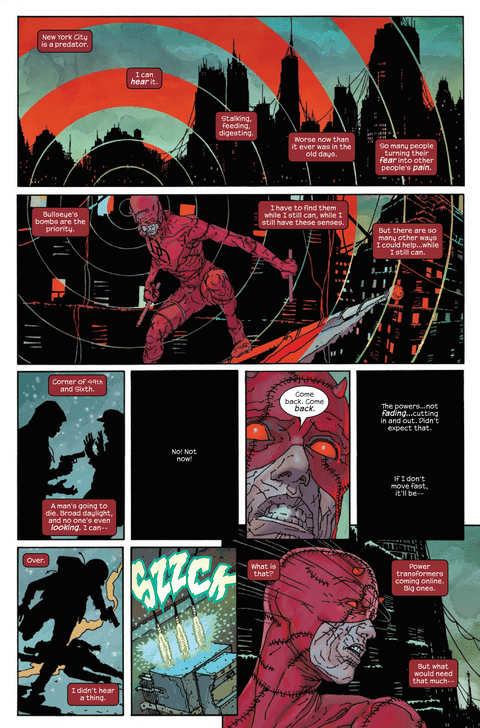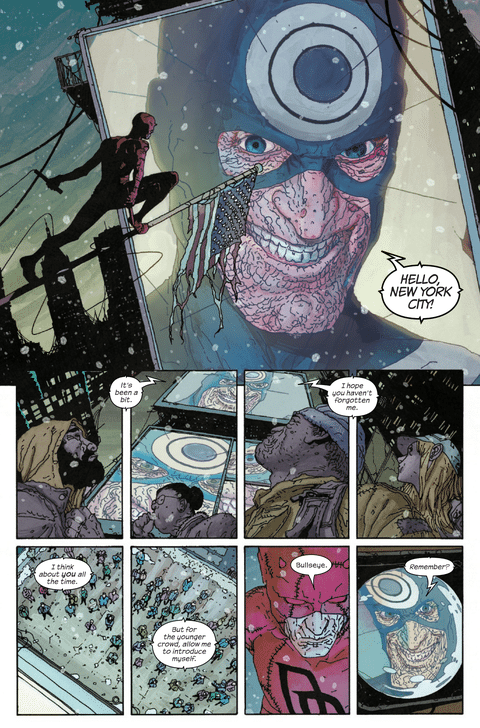Welcome back to the Marvel Rundown true believers! We might be in the dog days of summer and everywhere in American is like living inside an oven but Marvel this week brings some chilly weather with them. Well at least the conclusion of Daredevil: Cold Day in Hell #3 by Charles Soule, Steve McNiven, and Dean White brings some winter weather. This review contains SPOILERS so go to the end for final opinion. Elsewhere, readers make sure that the Rapid Rundown doesn’t breeze by you with reviews of Star Wars: Legacy of Vader #7 and One World World Under Doom #6.
As always, The Beat wants to hear from you, True Believers! Tell us what you think of this week’s Marvel Comics! Shout us out in the comment section below or over on social media @comicsbeat, or @comicsbeat.bsky.social, and let us know.
 Art by Steve McNiven
Art by Steve McNivenDaredevil: Cold Day in Hell #3
Writer: Charles Soule
Artist: Steve McNiven
Colorist: Dean White
Letter: Clayton Cowles
Let’s be honest, Daredevil: Cold Day in Hell has been one of the best Marvel mini series in a very long time and with this conclusion cements that. I’ve covered every issue here at the Rundown because there was no another Marvel book like it on the stands. The story created by Charles Soule and Steve McNiven is a knowing send off to one of the all time great Marvel characters. Daredevil is a character with a rich history and whose adventures produced some of the best stories Marvel has ever published With this final issue, Soule and McNiven add to that history with one of the best featuring this character in recent years.
The final issue brings into focus so many of this book’s themes. If this book is about anything it’s about the final redemption of Matt Murdock. Frank Miller introduced the character’s Catholicism as a way to explain why a lawyer would also break the law as a vigilante. Other writers though have gone deeper into these beliefs and how that affects his actions. The duality between the righteous vengeance of Daredevil and the penitent Matt Murdock who always worried his actions only made things worse. A man whose faith questioned if what was his God’s plan to do with these abilities.
The story that Soule and McNiven wrote over these three issues has Murdock attempt to make sense of his life and the gifts that terrible accident gave him. Especially now after years that he didn’t have them. This is a character who has suffered and brought suffering on others. So why was this the moment that they had to return? Were these abilities worth the loss and suffering they brought? Should he have done more than them? Was it all worth it?
 Art by Steve McNiven
Art by Steve McNivenHe has to ponder these questions as he’s on a deadline as his powers are running out and longtime foe Bullseye planted dirty bombs throughout New York. While the series has been leading up to this confrontation, Soule and McNiven make this a pathetic last confrontation. Here’s two lifelong enemies no longer at their peak, men with bodies on the decline, now ready for one last all out fight. McNiven depicts their bodies as these frail, desiccated things. In his drawings, they become fragile long limbed men in tattered costumes.
Daredevil’s abilities as a fighter rely on his superhuman sense which are failing him. McNiven creates a rhythm of black panels as the decline in ability becomes more permanent. Bullseye the master assassin, a killer able to hit any mark, can’t hold anything steady. He’s forced to use multiple projectiles when one used to suffice. There’s no reason these two should fight as their bodies fail them but they are men of violence. This life is all they know. McNiven’s art has been the main selling point
Speaking of men of violence, one of the more horrific elements in this comic is the fate of Frank Castle, The Punisher. Marvel’s most violent character spent most of this story dismembered by Bullseye and displayed. He finally gets a moment where he is as determined as ever to fulfill his one man war on crime, crawls on his what’s left of his limbs into a disused Iron Man suit and kills most of his captors. But even then his final act of determination to kill Bullseye for his years of captivity becomes pointless when Daredevil kills him by accident or out of necessity.
 Art by Steve McNiven
Art by Steve McNivenMore than any previous issue, the callbacks in this feel the most purposeful. Bullseye’s set up recalls Daredevil #146 where the assassin goads the hero into fighting him on TV. McNiven intercuts Murdock fatally putting Castle into a sleeper hold with images of Punisher killing a foe in cold blood in their younger days. Even Bullseye’s final act using a tooth, evokes memories of the many bizarre methods he’s used over the years to kill people. As we near the end, we remember the beginning.
That’s what is most striking about this comic is the finality of it all. Daredevil: Cold Day in Hell opened with Daredevil confronting mortality by visiting Kingpin’s grave. This series was about the end of the age of marvels, and with the almost nuclear color palette courtesy of both McNiven and colorist Dean White, maybe the end of the world. It ends with his and Bullseye’s death. But also the possible new age of superheroes and supervillains begins for this new world. The end of one age of heroes creates a new one. However it all ends with a dying Matt Murdock, like a good Catholic, once again asking if the suffering he endured was worth and this final act redeemed him in the end. Soule and McNiven don’t provide a comfortable answer, but they’ve provided three issues that create one hell of a story.
Verdict: BUY
Rapid Rundown
- Star Wars: Legacy of Vader #7
- After a soft couple years from Marvel’s Star Wars line I am thrilled to have two rock solid series. Legacy of Vader’s exploration of Kylo Ren in the wake of assuming the role of Supreme Leader after The Last Jedi remains a compelling character of exploration of a deeply disturbed character. Kylo is the obvious highlight of the sequel trilogy cast and there is so much to mine from this character between films. Charles Soule brings us into his conflicted world and reminds us that at his heart, Kylo Ren is an angry child trying desperately to convince himself and everyone around him he is as big and bad as he pretends to be. The art by Luke Ross captures Adam Driver’s likeness and the physicality of his erratic performance. In this issue, Kylo hunts down one of the last surviving Jedi of Vader’s purge, whose backstory adds new wrinkles of complexity to the order and even to Luke’s story in the sequel. Soule focuses in on the tortured personality at the heart of the lead, and the Jedi challenged the young warlord’s idea of the stories he has been told. This is a quieter chapter but more compelling for it. Nolan Woodard provides the moody colors, a rich play of cold blues and crackling red highlights from Kylo’s saber. Joe Caramagna does great work as always but especially stands out in his work selling the emotion on the final page. Legacy of Vader is well worth the time even for sequel skeptics for the way it enriches one of the franchise’s newest iconic characters. – Tim Rooney
- One World Under Doom #06
- This issue of One World Under Doom, writer Ryan North is on that soapbox, and I’m all in. For several months now, Dr. Doom has held the mantle of Sorcerer Supreme and effectively runs the show, and Earth’s Heroes have taken L after L trying to unseat him. Encounter after encounter, Doom has been winning the public relations battle. In what would seem like the ultimate level of arrogance, Reed Richards, aka Mr. Fantastic, in front of the world, challenges Doom to a televised debate for “the soul” of humanity. I’m a sucker for a great moral fight like Marvel’s first Civil War, where Cap and Tony were both right, so picking a side was tough. But here we know Doom is evil as F’ and he does that Kilmonger thing of using atrocities as camouflage for his personal agenda. Without spoiling too much, Doom hits Reed with a scroll’s worth of things that superheroes can do to make the world better but don’t, Reed’s counter Doom knew about the Vampires and did nothing, and it’s in these moral shadows that North is able to make Doom seem like an A-hole, but an A-hole who’s is about doing things and Reed the do-nothing nice guy, read into that what you will about our current political climate. While Doom is occupied using Reed as a PR punching bag, Maria Hill helps the Heroes get their stuff together and penetrate the magic dome over Latveria to uncover Doom’s secret, and this is important, but the meat of this is back in the studio as these two men debate. There is a ton of dialogue and data dumps in this issue, but artist R.B. Silva, color artist David Curiel, and the letterer (a position I often overlook), VC’s Travis Lanham, deliver a fusion of comic book storytelling with infographic aesthetics, and it works. Also, Doom in a suit with the signature cufflinks is amazing. This issue needs to be recognized as one of the great talking heads fights in Marvel history. – GC3
Come back next week for more reviews or go through our archives to read past reviews from the Rundown team!

 2 hours ago
1
2 hours ago
1



 English (US)
English (US)